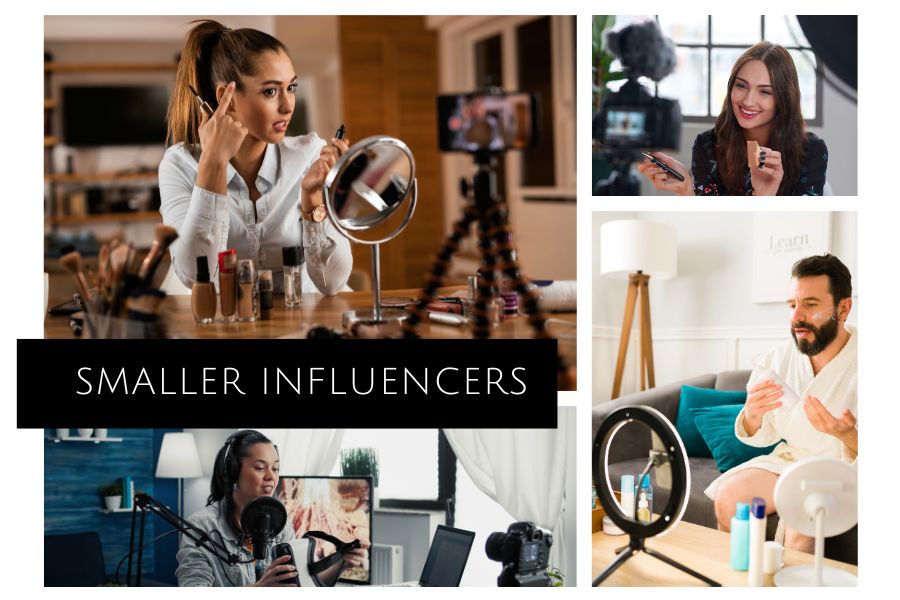As a digital marketing expert, I’ve observed the market trends, and it’s clear: Forget chasing follower vanity metrics! The social media landscape isn’t about empty stadiums anymore. Today’s hottest trend is the intimate concert hall, and smaller influencers are the captivating performers. Why? Because in today’s oversaturated world, authenticity reigns supreme (Edelman Trust Barometer, 2023). Micro-influencers feel relatable, fostering deeper connections and making their recommendations feel like a trusted friend’s tip, not just another advertisement.
Ready to ditch follower fatigue and embrace the micro-influencer revolution?
Buckle up and discover how to leverage their power to craft a winning social media strategy. This blog post is your backstage pass to unlocking their potential for impactful campaigns.
Understanding the Impact of Smaller Influencers
In recent years, we’ve witnessed a significant shift towards micro-influencers, individuals who may have a smaller following but wield immense influence within their niche communities. These influencers, typically ranging from 1,000 to 100,000 followers, offer a more targeted approach to marketing. Their specialization in specific topics or industries allows them to foster deeper connections and establish trust with their audience.
The Benefits of Collaborating with Smaller Influencers

Authenticity: Smaller influencers are perceived as more authentic and relatable by their followers. Their content feels genuine, creating a sense of trust that is invaluable for brands. When they endorse a product or service, their audience is more likely to view it as a genuine recommendation rather than a paid advertisement.
Targeted Reach: Micro-influencers cater to specific niches or demographics, making them ideal for targeted marketing campaigns. Whether it’s reaching fitness enthusiasts, beauty aficionados, or tech geeks, smaller influencers have the ability to connect with niche communities that may be challenging to reach through traditional advertising channels.
Higher Engagement Rates: Smaller influencer accounts often boast higher engagement rates compared to their larger counterparts. With a more intimate and engaged audience, their followers are more likely to interact with their content through likes, comments, and shares. This heightened level of engagement can significantly amplify the impact of a marketing campaign.
Cost-Effectiveness: Collaborating with smaller influencers is generally more cost-effective than partnering with mega influencers. Micro-influencers may charge lower fees or even accept product exchanges, making them an attractive option for businesses with limited marketing budgets.
Flexibility and Creativity: Smaller influencers often have more flexibility in their content creation process. They are open to experimenting with different formats, styles, and messaging, fostering creativity and allowing for more authentic collaborations.
Strategies for Maximizing the Impact of Smaller Influencers

Identify Relevant Influencers
Conduct thorough research to identify micro-influencers whose audience demographics and interests align with your brand. Look for individuals who have a genuine passion for your industry or product niche.
i. Define Your Target Audience:
- Who are you trying to reach?
- What are their demographics (age, location, interests)?
ii. Research Industry Hashtags:
- Identify relevant hashtags related to your brand and niche.
- Use social media platforms or tools like Hashtagify.me to find trending hashtags.
iii. Explore Social Media Platforms:
- Look for content using your industry hashtags.
- Engage with interesting posts and identify the creators (micro-influencers).
iv. Analyze Engagement Metrics:
- Don’t just focus on follower count.
- Look for influencers with high engagement rates (likes, comments, shares) compared to their follower base.
V. Content Authenticity:
- Read the influencer’s captions and posts.
- Do they seem passionate about your niche?
- Is their content authentic and engaging?
Example: Let’s say you sell eco-friendly yoga mats.
- You identify hashtags like #sustainableyoga, #ecoyogamat, #yogalife.
- On Instagram, you find a micro-influencer (@yogawithnature) with 15,000 followers who frequently posts yoga content using these hashtags.
- Their captions discuss the benefits of mindful yoga practice and using sustainable products.
- They have a high engagement rate, with followers commenting and asking questions.
Finding Influencers with Tools (Paid Options):

Several digital influencer marketing platforms can help you find micro-influencers based on specific criteria. These are paid services, but they offer advanced search features and analytics.
- HypeAuditor (https://hypeauditor.com/)
- Modash (https://www.modash.io/)
- Brand24 (https://brand24.com/)
Build Authentic Relationships:
Approach micro-influencer partnerships with a focus on mutual benefit and longevity, rather than isolated transactions. Cultivate relationships through active engagement on social media platforms, such as commenting on their posts, to establish rapport prior to proposing collaboration opportunities. Successful partnerships with micro-influencers are rooted in trust and sustained engagement. Move away from transactional approaches by actively supporting and engaging with influencers, demonstrating genuine interest in their content and expertise. Share valuable insights and transparently communicate your brand’s objectives to lay the foundation for a collaborative relationship built on trust and mutual respect.
Provide Creative Freedom:
Leverage the expertise and creative freedom of micro-influencers by respecting their authority within their niche and empowering their voice. Collaborate on ideas that align with your brand message while showcasing their unique style, without micromanaging content. Offer guidance and direction, but allow room for their personal flair to shine through. This fosters a sense of ownership and authenticity, ultimately leading to impactful content that resonates deeply with their audience and drives results for your brand.
Measure Performance:
Strategies for Maximizing the Impact of Smaller Utilize analytics tools to track the performance of influencer campaigns. Monitor metrics such as engagement rates, click-through rates, and conversions to gauge effectiveness and optimize future collaborations.
Example: Let’s say you’re a company selling organic skincare products and partner with a beauty influencer on Instagram who has a large following interested in natural beauty products.
Measuring Performance:

Analytics Tools: You can use Instagram Insights or a dedicated influencer marketing platform to track the influencer’s post about your products.
Metrics:
Engagement Rate: This shows how well the audience interacted with the post. Look at likes, comments, and shares. A high engagement rate suggests the influencer’s audience is interested in your brand.
Click-Through Rate (CTR): If the influencer included a link to your website in their post, the CTR measures how many people clicked the link. A good CTR indicates the audience is interested in learning more about your products.
Conversions: This is the ultimate measure of success. Did people who clicked the link from the influencer’s post actually buy something? You can track this with unique discount codes or UTM parameters in your website links.
Conclusion: Embracing the Power of Smaller Influencers
In conclusion, smaller influencers offer a unique opportunity for brands to achieve targeted reach and drive higher levels of engagement in their marketing efforts. By harnessing the authenticity, niche expertise, and engaged audience of micro-influencers, brands can unlock new avenues for success in the digital realm. As digital marketers, let’s embrace the power of smaller influencers and leverage their influence to propel our brands to new heights of success.
Top 20 Micro Influencers In Pakistan (Under 25k Followers) Read More
FAQs about Smaller Influencers
1. What defines a “smaller influencer” in digital marketing?
Smaller influencers, also known as micro-influencers, typically have a follower count ranging from 1,000 to 100,000. However, their influence is not solely determined by their follower count but also by their engagement rates and niche expertise.
2. How do smaller influencers contribute to targeted reach?
Smaller influencers often specialize in specific niches or demographics, allowing brands to reach their target audience more effectively. Their focused content attracts engaged followers who share similar interests, resulting in a more targeted reach for marketing campaigns.
3. Are smaller influencers more cost-effective than larger influencers?
Yes, collaborating with smaller influencers tends to be more cost-effective for brands. Micro-influencers may charge lower fees or accept product exchanges, making them an attractive option for businesses with limited marketing budgets.
4. How can brands build authentic relationships with smaller-influencers?
Brands can build authentic relationships with smaller influencers by engaging with them on social media, commenting on their posts, and establishing rapport before reaching out with collaboration opportunities. Approach influencer partnerships as mutually beneficial relationships rather than one-off transactions.
5. What metrics should brands track when measuring the performance of influencer campaigns?
Brands should track metrics such as engagement rates (likes, comments, shares), click-through rates, and conversions to gauge the effectiveness of influencer campaigns. Additionally, qualitative feedback and sentiment analysis can provide insights into the overall impact and perception of the brand.

